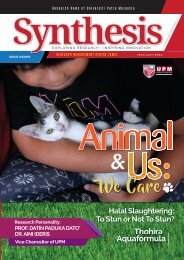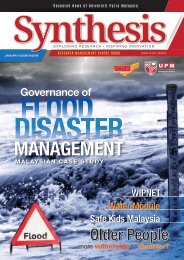SYNTHESIS 1/2020: CLIMATE CHANGE & DISEASE SHIFT IN MALAYSIA
Biomedical and health sciences research has always been the centre of focus in many countries for centuries. In fact, a portion of the tax-money has been allocated to research and development (R&D) in the country to improve the health and well-being of the people. The importance of R&D can be seen with the recent pandemic of COVID-19, which has swept the world with fear of the disease. Many parties are working together to curb the outbreak; healthcare providers nursing and treating the patients, scientists developing the virus detection system and vaccines, engineers creating tools for temperature detection and surface sanitising machine, and many more. All this expertise and creativity come from years of experience and hard work in R&D to create a better future for the nation and mankind.
Biomedical and health sciences research has always been the centre of focus in many countries for centuries. In fact, a portion of the tax-money has been allocated to research and development (R&D) in the country to improve the health and well-being of the people. The importance of R&D can be seen with the recent pandemic of COVID-19, which has swept the world with fear of the disease. Many parties are working together to curb the outbreak; healthcare providers nursing and treating the patients, scientists developing the virus detection system and vaccines, engineers creating tools for temperature detection and surface sanitising machine, and many more. All this expertise and creativity come from years of experience and hard work in R&D to create a better future for the nation and mankind.
You also want an ePaper? Increase the reach of your titles
YUMPU automatically turns print PDFs into web optimized ePapers that Google loves.
Special Highlights
Coronavirus
Coronaviruses (CoV) are a large family of viruses
and are broadly distributed in human and other
mammals such as cat, dog, bovine, pig, rodent,
bat as well as birds and chicken. The virus causes
respiratory disease in human and mammals.
In some mammals, it causes gastrointestinal
diseases as well. Currently, there are 7 types
of human coronaviruses namely HCoV-229E,
HCoV-OC43, HCoV-NL63, HCoV-HKU1, SARS-
CoV, MERS-CoV and SARS-CoV-2. The first
three cause mild respiratory diseases and are the
most common coronavirus causing respiratory
disease in human. The last four coronaviruses
can cause more severe respiratory diseases.
Human coronavirus was first discovered in the mid-1960s
and in 2003, a severe form of respiratory disease was
observed and was finally identified to be caused by a
new coronavirus, SARS-CoV. The discovery of SARS-CoV
marked the animal to human transmission of coronavirus.
Since then, additional four human coronaviruses were
found: HCoV-NL63, HCoV-HKU1, MERS-CoV and SARS-
CoV-2.
Coronavirus is an enveloped RNA virus with a genome
length of between 26-30 kb. The virus can be classified
into four main sub-groupings based on their genotypic and
serological characters namely alpha, beta, gamma and
delta coronavirus. HCoV-229E and HCoV-NL63 belong to
alpha coronavirus, while the other five human coronaviruses
belong to beta coronavirus.
Virions of coronavirus are roughly spherical and exhibit
moderate pleomorphic (having variation in size and shape).
Coronavirus has a structure of spikes on its surface which
resembles crown (crown in Latin is “corona”), therefore
the virus was named as coronavirus. The virus has four
structural proteins, envelope (E), membrane (M), spike (S)
and nucleocapsid (N). The spike protein is responsible for
the virus binding onto the host cell via a receptor molecule.
Assoc. Prof. Dr. Chee Hui Yee
Department of Medical Microbiology
and Parasitology
Faculty of Medicine and Health
Sciences
Tel: +603-9769 2576
Email: cheehy@upm.edu.my
In the end of 2019, Wuhan, China reported a cluster of
virus pneumonia cases and the clinical presentations
were different from other known viruses. The researchers
isolated the pathogen using human airway epithelial cells
from patient clinical samples and identified the virus as
coronavirus using transmission electron microscopy.
Following that, the genome of the virus was sequenced
and was shared publicly. Using the available genome
sequences, researchers from various countries started to
design SARS-CoV-2 detection kits for diagnosis.
The SARS-CoV-2 genome sequence showed sequence
diversity from other known coronaviruses. Based on
the size and genome organisation, the virus belongs
to the beta coronavirus with about 88%, 78% and 50%
sequence similarity with bat coronavirus, SARS and MERS,
respectively. Therefore, it was considered as a new virus
and was named as SARS-CoV-2, the causative agent
for SARS-CoV-2 which stands for the 2019 Coronavirus
Disease. Based on phylogenetic analyses, it was believed
that the origin of the SARS-CoV-2 was from a bat and
that bat infected an intermediate host which has yet to
be identified. Humans then interacted frequently with the
intermediate host and caused a cross-species transmission.
In the midst of fighting and finding antiviral for the new virus,
researchers used bioinformatics approaches to identify the
possible receptor for SARS-CoV-2 based on the genome
sequences by comparing with SARS-CoV-2 and MERS-
CoV sequences. They found that SARS-CoV-2 may use the
angiotensin-converting enzyme 2 (ACE2) as the receptor
due to the sequence and structure similarities of the spike
protein with those in SARS-CoV-2.
Using the information available and the isolated SARS-
CoV-2, researchers from various countries started to work
around the clock to search for an antiviral and a vaccine.
There are antivirals under clinical trials and some hospitals
have used Remdesivir, an analogue for the RNA-dependent
RNA Polymerase (RdRp) for Ebola virus and a combination
of anti-HIV drugs, Lopinavir/Ritonavir, protease inhibitors
to treat critically ill patients. The results were encouraging.
Following the success of the repurposing the above drugs,
now Favipiravir, an RdRp inhibitor and Umifenovir, an
anti-influenza drug are amongst those under clinical trials
with promising preliminary results. Besides searching and
testing for antivirals, vaccines are also under development.
There is no doubt that developing a vaccine is the solution
to prevent the infection.
Through dedicated, active and extensive collaborations
among researchers and doctors around the globe, we are
confident that we will contain the virus and stop the disease
in the very near future.
24 | ISSUE 01/2020










